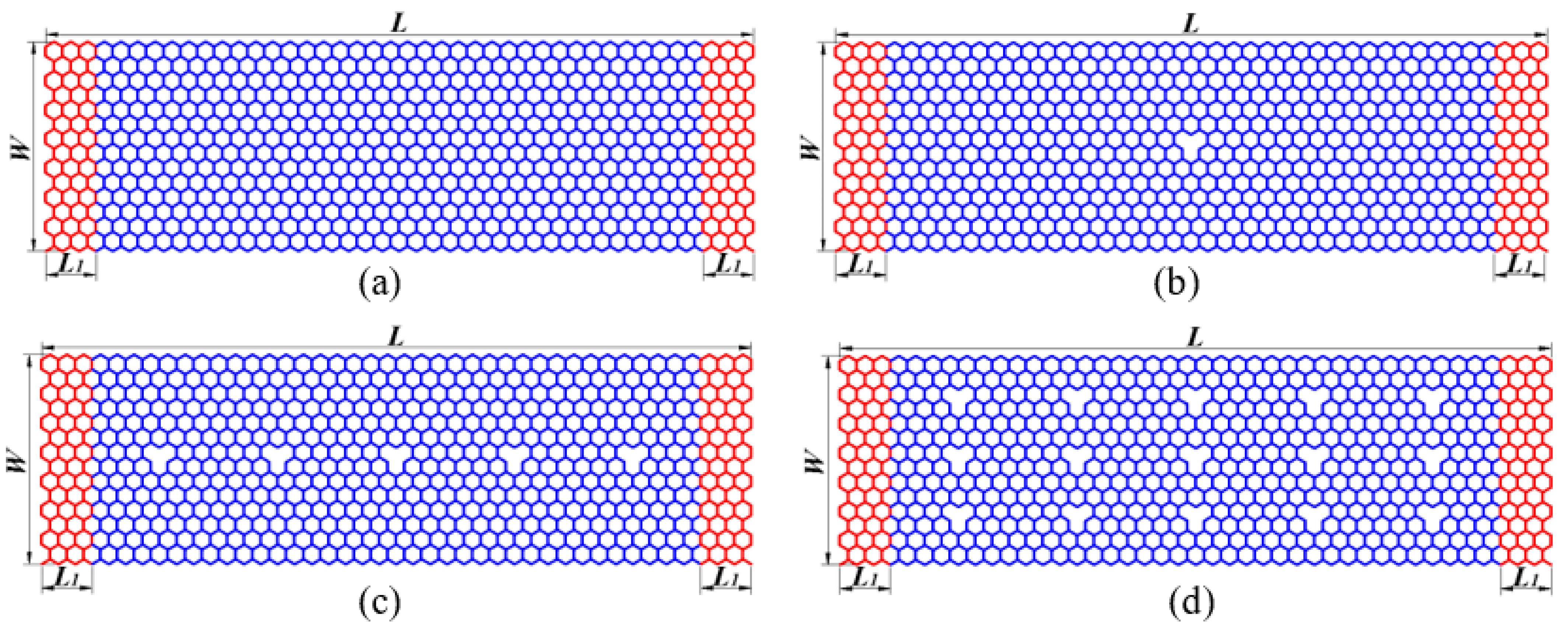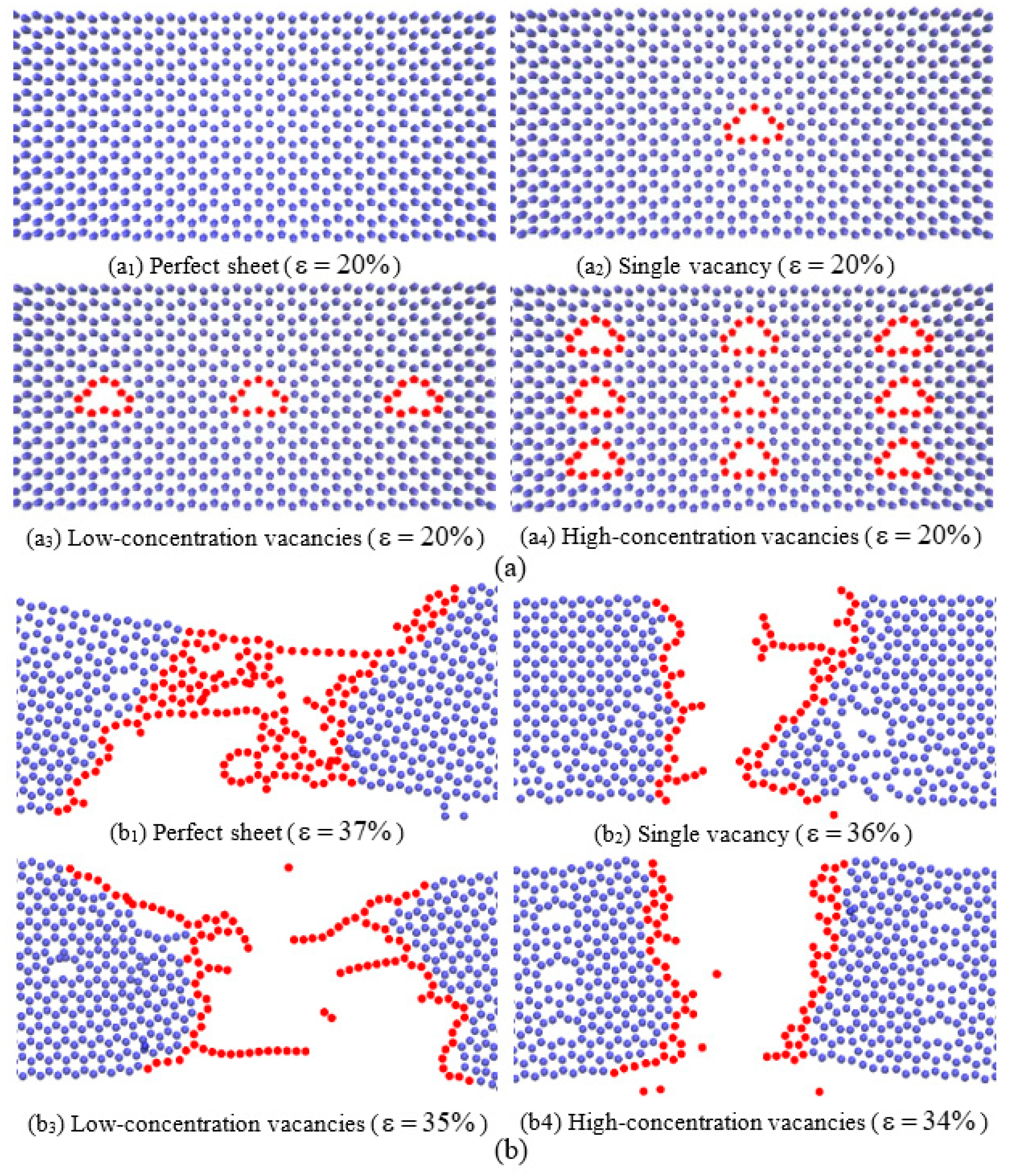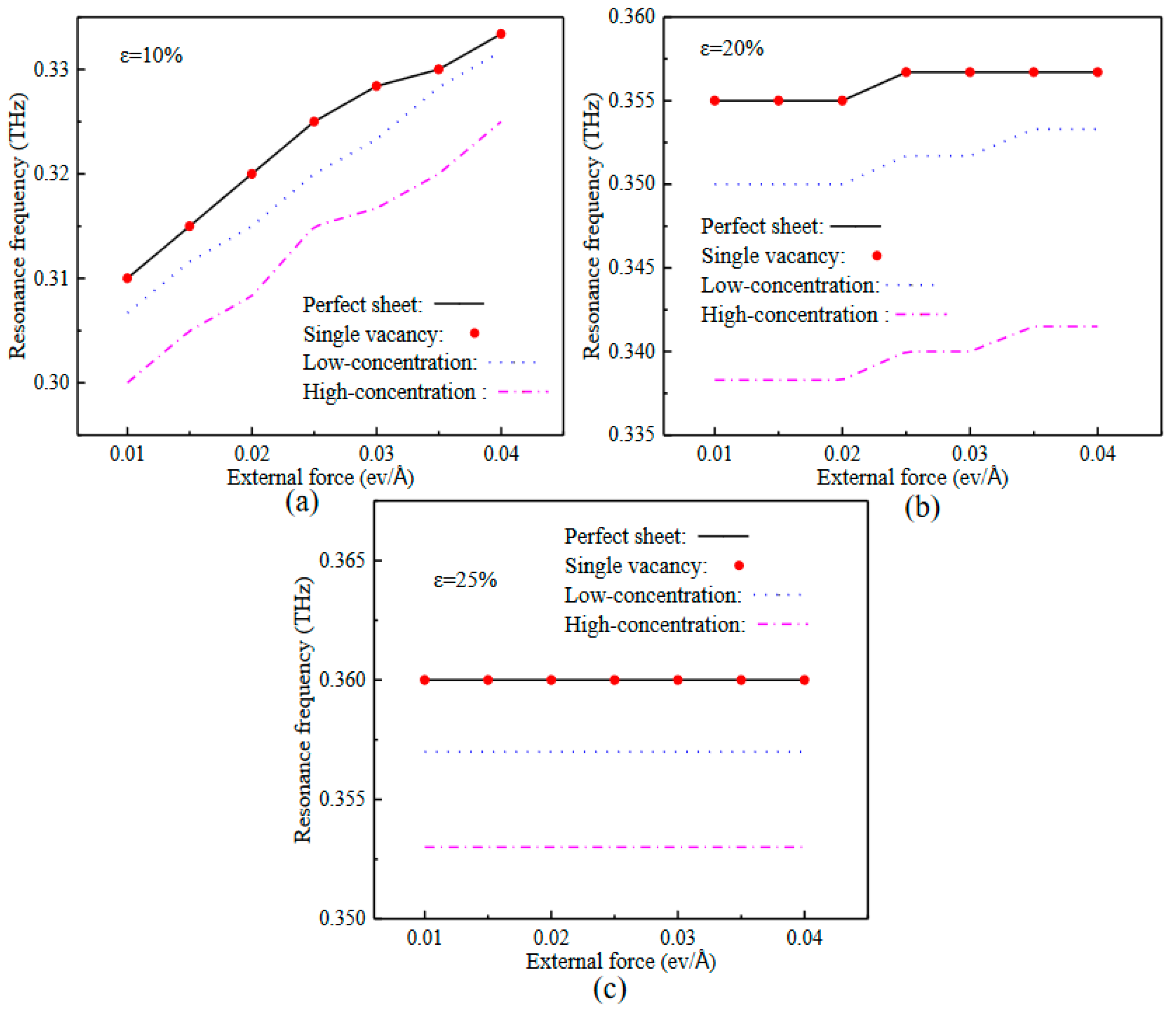Molecular Dynamic Simulation of Defective Graphene Nanoribbons for Tension and Vibration
Abstract
:1. Introduction
2. Materials and Methods
3. Results and Discussion
4. Conclusions
Author Contributions
Funding
Data Availability Statement
Conflicts of Interest
References
- Bunch, J.S.; Van Der Zande, A.M.; Verbridge, S.S.; Frank, I.W.; Tanenbaum, D.M.; Parpia, J.M.; Craighead, H.G.; McEuen, P.L. Electromechanical resonators from graphene sheets. Science 2007, 315, 490–493. [Google Scholar] [CrossRef] [PubMed] [Green Version]
- Chen, C.; Rosenblatt, S.; Bolotin, K.I.; Kalb, W.; Kim, P.; Kymissis, I.; Stormer, H.L.; Heinz, T.F.; Hone, J. Performance of monolayer graphene nanomechanical resonators with electrical readout. Nat. Nanotechnol. 2009, 4, 861–867. [Google Scholar] [CrossRef] [PubMed] [Green Version]
- Garcia-Sanchez, D.; van der Zande, A.M.; Paulo, A.S.; Lassagne, B.; McEuen, P.L.; Bachtold, A. Imaging mechanical vibrations in suspended graphene sheets. Nano Lett. 2008, 8, 1399–1403. [Google Scholar] [CrossRef] [PubMed] [Green Version]
- Xie, T.; Wang, Q.; Wallace, R.M.; Gong, C. Understanding and optimization of graphene gas sensors. Appl. Phys. Lett. 2021, 119, 013104. [Google Scholar] [CrossRef]
- Lei, G.; Cheng, H.; Liu, H.; Rao, W. Thermal rectification in asymmetric graphyne nanoribbons: A nonequilibrium molecular dynamics study. Mater. Lett. 2017, 189, 101–103. [Google Scholar] [CrossRef]
- Tsai, J.L.; Tu, J.F. Characterizing mechanical properties of graphite using molecular dynamics simulation. Mater. Design 2010, 31, 194–199. [Google Scholar] [CrossRef]
- Mamin, H.J.; Rugar, D. Sub-attonewton force detection at millikelvin temperatures. Appl. Phys. Lett. 2001, 79, 3358–3360. [Google Scholar] [CrossRef]
- LaHaye, M.D.; Buu, O.; Camarota, B.; Schwab, K.C. Approaching the quantum limit of a nanomechanical resonator. Science 2004, 304, 74–77. [Google Scholar] [CrossRef] [Green Version]
- Yang, Y.T.; Callegari, C.; Feng, X.L.; Ekinci, K.L.; Roukes, M.L. Zeptogram-scale nanomechanical mass sensing. Nano Lett. 2006, 6, 583–586. [Google Scholar] [CrossRef]
- Zhang, Z.; Lan, L.; Wang, Y.; Wang, C. Vibration frequency analysis of rippled single-layered graphene sheet: Toward the nano resonant devices design. Physica E 2019, 114, 113580. [Google Scholar] [CrossRef]
- Reddy, C.; Rajendran, S.; Liew, K. Equilibrium configuration and continuum elastic properties of finite sized graphene. Nanotechnology 2006, 17, 864. [Google Scholar] [CrossRef]
- Sakhaee-Pour, A.; Ahmadian, M.T.; Naghdabadi, R. Vibrational analysis of single-layered graphene sheets. Nanotechnology 2008, 19, 085702. [Google Scholar] [CrossRef] [PubMed]
- Kang, J.W.; Hwang, H.J.; Kim, K.S. Molecular dynamics study on vibrational properties of graphene nanoribbon resonator under tensile loading. Comput. Mater. Sci. 2012, 65, 216–220. [Google Scholar] [CrossRef]
- Yang, X.; Xu, J.; Wu, S.; Yu, D.; Cao, B. Molecular dynamics simulation of double-layered graphene-carbon nanotube junctions for thermal rectification. Mater. Lett. 2019, 234, 357–360. [Google Scholar] [CrossRef]
- Dresselhaus, M.; Jorio, A.; Souza Filho, A.; Saito, R. Defect characterization in graphene and carbon nanotubes using Raman spectroscopy. Philos. Trans. R. Soc. A 2010, 368, 5355–5377. [Google Scholar] [CrossRef]
- Carpenter, C.; Ramasubramaniam, A.; Maroudas, D. Analysis of vacancy-induced amorphization of single-layer graphene. Appl. Phys. Lett. 2012, 100, 203105. [Google Scholar] [CrossRef]
- Banhart, F.; Kotakoski, J.; Krasheninnikov, A.V. Structural defects in graphene. ACS Nano 2011, 5, 26–41. [Google Scholar] [CrossRef] [Green Version]
- Zhao, S.Y.; Zhang, Y.Y.; Yang, J.; Kitipornchai, S. Improving interfacial shear strength between graphene sheets by strain-induced wrinkles. Carbon 2020, 168, 135–143. [Google Scholar] [CrossRef]
- Savin, A.V.; Kivshar, Y.S. Localized defect modes in graphene. Phys. Rev. B 2013, 88, 125417. [Google Scholar] [CrossRef] [Green Version]
- Li, L.L.; Sun, R.; Zhang, Y.H.; Kitipornchai, S.; Yang, J. Mechanical behaviours of graphene reinforced copper matrix nanocomposites containing defects. Comput. Mater. Sci. 2020, 182, 109759. [Google Scholar] [CrossRef]
- Zandiatashbar, A.; Lee, G.H.; An, S.J.; Lee, S.; Mathew, N.; Terrones, M.; Hayashi, T.; Picu, C.R.; Hone, J.; Koratkar, N. Effect of defects on the intrinsic strength and stiffness of graphene. Nat. Commun. 2014, 5, 3186. [Google Scholar] [CrossRef] [PubMed]
- Warner, J.H.; Margine, E.R.; Mukai, M.; Robertson, A.W.; Giustino, F.; Kirkland, A.I. Dislocation-driven deformations in graphene. Science 2012, 337, 209–212. [Google Scholar] [CrossRef] [PubMed] [Green Version]
- Liu, T.H.; Pao, C.W.; Chang, C.C. Effects of dislocation densities and distributions on graphene grain boundary failure strengths from atomistic simulations. Carbon 2012, 50, 3465–3472. [Google Scholar] [CrossRef]
- Carpenter, C.; Maroudas, D.; Ramasubramaniam, A. Mechanical properties of irradiated single-layer graphene. Appl. Phys. Lett. 2013, 103, 013102. [Google Scholar] [CrossRef]
- Chu, L.; Shi, J.; Souza de Cursi, E. Vibration analysis of vacancy defected graphene sheets by Monte Carlo based finite element method. Nanomaterials 2018, 8, 489. [Google Scholar] [CrossRef] [Green Version]
- Allahyari, E.; Fadaee, M. Analytical investigation on free vibration of circular double-layer graphene sheets including geometrical defect and surface effects. Engineering-Prc 2016, 85, 259–267. [Google Scholar] [CrossRef]
- Braun, M.; Arca, F.; Ariza, M. Computational assessment of Stone-Wales defects on the elastic modulus and vibration response of graphene sheets. Int. J. Mech. Sci. 2021, 209, 106702. [Google Scholar] [CrossRef]
- Chen, X.K.; Liu, J.; Xie, Z.X.; Zhang, Y.; Deng, Y.X.; Chen, K.Q. A local resonance mechanism for thermal rectification in pristine/branched graphene nanoribbon junctions. Appl. Phys. Lett. 2018, 113, 121906. [Google Scholar] [CrossRef]
- Mortazavi, B.; Ahzi, S. Thermal conductivity and tensile response of defective graphene: A molecular dynamics study. Carbon 2013, 63, 460–470. [Google Scholar] [CrossRef]
- Sun, R.; Li, L.; Feng, C.; Kitipornchai, S.; Yang, J. Tensile behavior of polymer nanocomposite reinforced with graphene containing defects. Eur. Polym. J. 2018, 98, 475–482. [Google Scholar] [CrossRef]
- Stuart, S.J.; Tutein, A.B.; Harrison, J.A. A reactive potential for hydrocarbons with intermolecular interactions. J. Chem. Phys. 2000, 112, 6472–6486. [Google Scholar] [CrossRef] [Green Version]
- Bu, H.; Chen, Y.F.; Zou, M.; Yi, H.; Bi, K.D.; Ni, Z.H. Atomistic simulations of mechanical properties of graphene nanoribbons. Phys. Lett. A 2009, 373, 3359–3362. [Google Scholar] [CrossRef]
- Li, L.L.; Yang, J. Mechanical properties of prestrained single-layer black phosphorus: Effect of thermal environment. Nanotechnology 2017, 28, 475701. [Google Scholar] [CrossRef] [PubMed] [Green Version]





Publisher’s Note: MDPI stays neutral with regard to jurisdictional claims in published maps and institutional affiliations. |
© 2022 by the authors. Licensee MDPI, Basel, Switzerland. This article is an open access article distributed under the terms and conditions of the Creative Commons Attribution (CC BY) license (https://creativecommons.org/licenses/by/4.0/).
Share and Cite
Mao, J.-J.; Liu, S.; Li, L.; Chen, J. Molecular Dynamic Simulation of Defective Graphene Nanoribbons for Tension and Vibration. Nanomaterials 2022, 12, 2407. https://doi.org/10.3390/nano12142407
Mao J-J, Liu S, Li L, Chen J. Molecular Dynamic Simulation of Defective Graphene Nanoribbons for Tension and Vibration. Nanomaterials. 2022; 12(14):2407. https://doi.org/10.3390/nano12142407
Chicago/Turabian StyleMao, Jia-Jia, Shuang Liu, Lili Li, and Jie Chen. 2022. "Molecular Dynamic Simulation of Defective Graphene Nanoribbons for Tension and Vibration" Nanomaterials 12, no. 14: 2407. https://doi.org/10.3390/nano12142407
APA StyleMao, J.-J., Liu, S., Li, L., & Chen, J. (2022). Molecular Dynamic Simulation of Defective Graphene Nanoribbons for Tension and Vibration. Nanomaterials, 12(14), 2407. https://doi.org/10.3390/nano12142407





